

 CONTENTS
CONTENTS

 CHAPTER 1
CHAPTER 1
INTRODUCTION
RUNNING. Thats what runners do. They run in order to get better at running, right? The more you run, the faster youll go. Who can argue with that? Well, here I go If you want to remain injury-free, become a better runner and run faster, I maintain that theres more to training than just running. There, Ive said it. And in this book I intend to explain why, and set out what more you need to do to be a fitter, stronger and faster runner.
The misconception that running more miles delivers an improved performance is deep-rooted in the sport. The concept of junk miles moderate tempo running just to reach a distance goal has persuaded many runners to incorporate hill runs, speed intervals and form drills into their training, but it is still not uncommon to find even elite athletes diligently turning out 125-mile weeks for no clear reason.
There is no denying the stories of runners who reduce their PBs over a short period of time and these always make a great impression on novice runners. But there is another, less inspiring, side to the stories: the frustrating plateauing and the 3050 per cent of runners who, over a 12-month period, suffer injuries. These are often written off as inevitabilities crosses the dedicated runner has to bear but I aim to show you it doesnt have to be that way.
The simple act of running utilises hundreds of the bodys muscles. Every time you run youre using these muscles, forcing them to contract and relax over and over again. Understandably, you might think its logical that running strengthens muscles: more running equals stronger muscles, meaning fewer injuries and faster times. And the rationale stands up for a while until a muscle gives way under the strain or fails to develop at the rate necessary to increase speed.
Training is purely a stimulus for your body a way of making it fight to become fitter, stronger or more flexible. Our body is designed to respond to such stimuli, but a single form of training in this case, running will not enable it to deliver beyond its capabilities. If were going to increase speed and withstand injury, we need to look to other ways to strengthen the parts of the body that deliver the power and bear the load.
WHY WE STRETCH
When physiotherapists and coaches talk about athletes bodies they will speak of range of motion (ROM), meaning the available amount of movement of a joint, and flexibility, meaning the ability of soft tissue structures (such as muscle, tendon and connective tissue) to elongate through the available range of joint motion. Both of these can be vastly improved through stretching. During a stretch, the muscle fibres elongate to their optimum range. The bodys nervous system gradually adjusts to the discomfort of the stretch, allowing you to both tolerate and potentially increase the available capacity of the muscle. When we next stretch the muscle, in training or in performance, it should be less likely to become over-stressed, and it will be able to provide more range of movement for the required actions of running.
The range of motion and flexibility required varies across sporting disciplines. Although sportsmen and women all need strong and healthy bodies, a swimmer will have different demands to a cyclist or a footballer. Running has limited requirements compared to, for example, martial arts or gymnastics, and yet there are still many areas of the body key to the running action. Your core muscles keep the spine strong and versatile while providing stability. Your posterior chain glutes, hamstrings, calves help propel the body forwards and the shoulders, neck, arms, thighs and feet are almost as critical in the process. The aim of this book is to pinpoint the exercises that specifically target areas of potential weakness or possible strength for the runner.
Few take up running to spend their time exercising indoors, but anyone taking their sport seriously has little alternative: you need to train to train. Just 1015 minutes a day, or even 30 minutes every other day, spent stretching can build the strength and flexibility of the key muscle areas specific to running. Its time well spent, and can save you weeks of running with a niggling pain or even months of inactivity while you rehab from injury.

HOW WE STRETCH
Most runners are accustomed to stretching before a run and in a post-run warm-down, but theyre often perfunctory, barely remembered warm-ups from gym classes or intuitive stretches based on previous injuries to calves, quads or hamstrings. Far fewer runners practise routines on a daily basis and even those who regularly visit the gym or attend circuit training classes are not performing running-specific exercises.
How we stretch matters. After all, we spend the whole day stretching in some form, from cleaning our teeth to reaching for a can of tomatoes on the top shelf. However, these are not preparing us for sport. There are several methods of stretching that can improve range of motion and enhance muscular performance, and when and why we perform each of them are key to their effectiveness. The ones featured in this book include:
 STATIC STRETCHING the type with which runners are most familiar, whereby a muscle is slowly stretched to a challenging but comfortable point that is then held for 3060 seconds.
STATIC STRETCHING the type with which runners are most familiar, whereby a muscle is slowly stretched to a challenging but comfortable point that is then held for 3060 seconds.
 STRETCHING which involves repeating a movement through a range of motion, such as swinging your leg.
STRETCHING which involves repeating a movement through a range of motion, such as swinging your leg.
 PASSIVE STRETCHING where muscles are taken through their range of motion by an external force, such as a strap, your own limbs or with the help of a partner.
PASSIVE STRETCHING where muscles are taken through their range of motion by an external force, such as a strap, your own limbs or with the help of a partner.
Increasingly, experts are favouring the dynamic stretches since they are more effective in building muscle strength, but as the book will detail, there is still an important role for static stretching.
STRENGTH AND CONDITIONING
As a specialist running physiotherapist, I treat elite athletes. They all follow some form of strength and conditioning (S&C) programme and see it as a vital part of their training. Strength and conditioning programmes use prescribed exercises specifically to improve performance in athletic competition. They encompass everything about the physical development of the athlete in regards to their sport, including strength, co-ordination, flexibility, power, agility and balance.
In professional cycling, the idea of marginal gains incremental improvements from diverse areas that enhance overall performance has led to some serious advances. In the same way, elite runners are looking for any percentage increase in the strength of key muscles and, for club or casual runners, the benefits can be more than marginal; they can make a significant difference to your strength and, consequently, your running speed and race times.


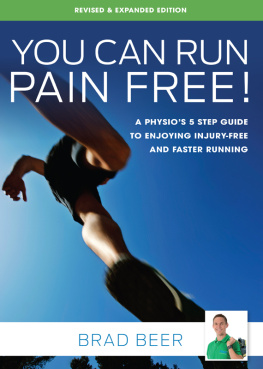
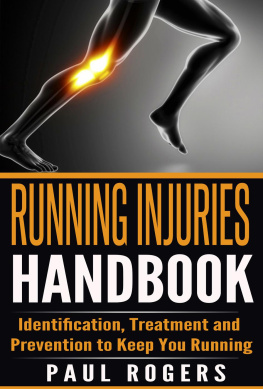

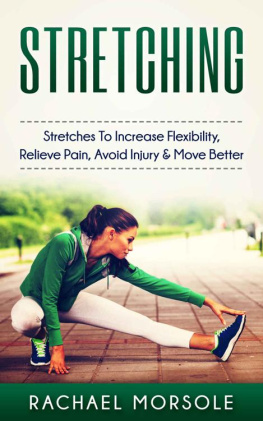
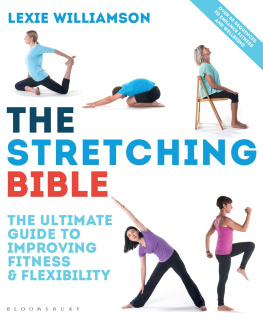
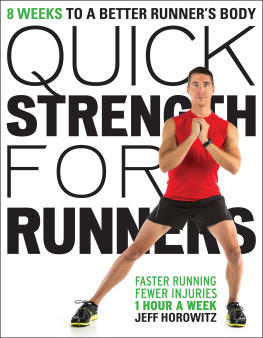

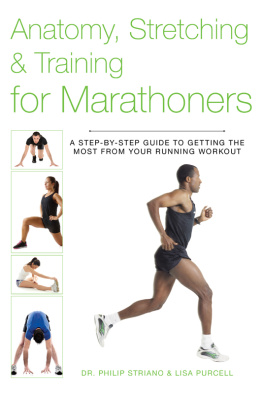
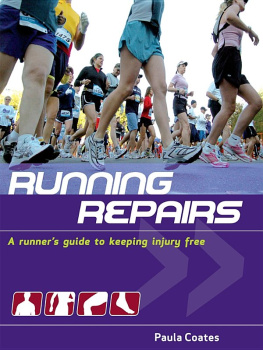




 CONTENTS
CONTENTS
 CHAPTER 1
CHAPTER 1
 STATIC STRETCHING the type with which runners are most familiar, whereby a muscle is slowly stretched to a challenging but comfortable point that is then held for 3060 seconds.
STATIC STRETCHING the type with which runners are most familiar, whereby a muscle is slowly stretched to a challenging but comfortable point that is then held for 3060 seconds.